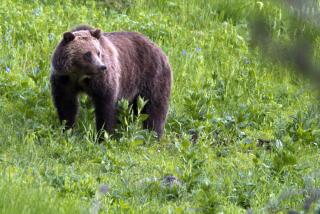For Carnivores, Small Means Versatile
- Share via
Fossils from extinct dogs show why bigger is not always better: Giant meat-eating animals died out because they relied too heavily on hunting other big animals, scientists reported Thursday.
Smaller, quicker carnivores could vary their diet more, hunting small rodents and mixing in berries, roots and other food sources, said Blaire van Valkenburgh and colleagues at UCLA.
But once a carnivore reached a certain size, it would spend more energy hunting than it would get from small prey, and had to rely on big game, they report in the current issue of the journal Science. And that made them less adaptable.
This could help explain the mass extinctions of many giant animals called megafauna that dominated and then disappeared from North America over the last 50 million years.
Van Valkenburgh’s team studied a range of fossils from extinct canids, a grouping or “clade” of animals that includes wolves, foxes, coyotes and dogs.
Canids that fed on large prey tended to have deeper jaws, long shearing teeth and few molars for grinding food. They ranged in size from that of a small fox to about the size of a large wolf.
As they got bigger, their teeth adapted more and more for ripping flesh and crushing bone and became less suited for chewing other foods.
“As mean body size increased, species evolved into specialized hypercarnivores,” Van Valkenburgh’s team wrote.
None of the hypercarnivores lasted for more than 6 million years, whereas more omnivorous species endured for as long as 11 million years, they found.
More to Read
Sign up for Essential California
The most important California stories and recommendations in your inbox every morning.
You may occasionally receive promotional content from the Los Angeles Times.













